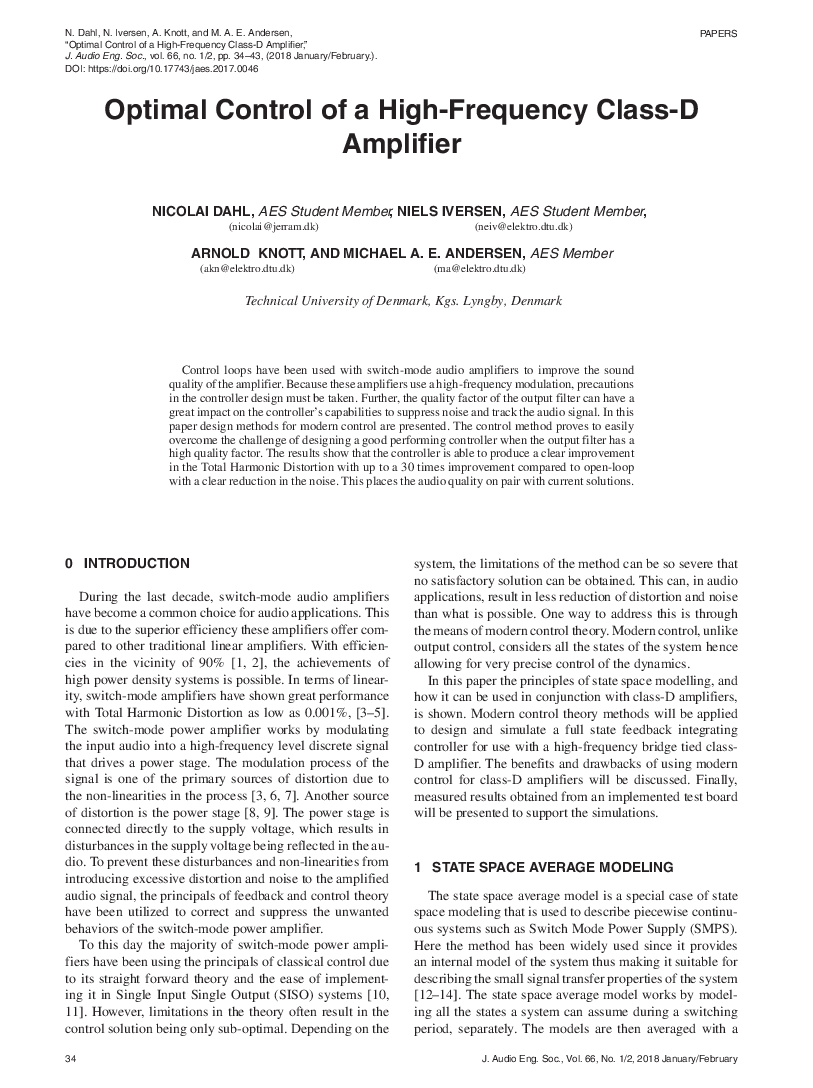Home / Publications / E-library page
You are currently logged in as an
Institutional Subscriber.
If you would like to logout,
please click on the button below.
Home / Publications / E-library page
Only AES members and Institutional Journal Subscribers can download
During the last decade, switch-mode audio amplifiers have become a common choice for audio applications because of efficiencies approaching 90% and distortions as low as 0.001%. Such amplifiers modulate the input audio into a high-frequency discrete signal that drives a Class-D power stage. The control loop is the key element in achieving high-quality performance. Modern control theory methods were used to design and simulate a full-state feedback integrating controller for use with a high-frequency bridge class-D amplifier. An optimal linear full-state integral controller based on the state-space model was designed using the Linear Quadratic Regulator (LQR) method, and verified on a linear and switching model. Measurements on a Class-D amplifier with the implemented controller showed that the step responses and THD+N measurements were aligned with theoretic predictions. A 30-fold reduction in THD+N was observed compared to open-loop. The results prove that the principals of modern control achieve good performance in Class-D amplifiers, even when the output filter has a large resonance.
Author (s): Dahl, Nicolai; Iversen, Niels; Knott, Arnold; Andersen, Michael A. E.
Affiliation:
Technical University of Denmark, Kgs. Lyngby, Denmark
(See document for exact affiliation information.)
Publication Date:
2018-01-06
Import into BibTeX
Permalink: https://aes2.org/publications/elibrary-page/?id=19374
(475KB)
Click to purchase paper as a non-member or login as an AES member. If your company or school subscribes to the E-Library then switch to the institutional version. If you are not an AES member Join the AES. If you need to check your member status, login to the Member Portal.

Dahl, Nicolai; Iversen, Niels; Knott, Arnold; Andersen, Michael A. E.; 2018; Optimal Control of a High Frequency Class-D Amplifier [PDF]; Technical University of Denmark, Kgs. Lyngby, Denmark; Paper ; Available from: https://aes2.org/publications/elibrary-page/?id=19374
Dahl, Nicolai; Iversen, Niels; Knott, Arnold; Andersen, Michael A. E.; Optimal Control of a High Frequency Class-D Amplifier [PDF]; Technical University of Denmark, Kgs. Lyngby, Denmark; Paper ; 2018 Available: https://aes2.org/publications/elibrary-page/?id=19374
@article{dahl2018optimal,
author={dahl nicolai and iversen niels and knott arnold and andersen michael a. e.},
journal={journal of the audio engineering society},
title={optimal control of a high frequency class-d amplifier},
year={2018},
volume={66},
issue={1/2},
pages={34-43},
month={january},}